|
During World War II,
Russia was considered an ally, being part of the Allied forces battling the Axis
powers. The Allied countries
were primarily the USA, England, France, the Soviet Union, China, Canada, and Australia.
The Axis of evil was
Germany, Japan, and Italy, with a few minor countries like Romania, Finland, Hungary,
Croatia, and Thailand giving aid and comfort. Interesting, isn't it, that after
saving Russia from the Germans and China from the Japanese, they almost immediately
became our arch enemies, seeking to destroy the "Capitalist Pigs." Reportedly, Stalin
was originally to join with Hitler, but the two could not agree on how to share
power in the event of victory. Negotiations went awry after both countries invaded
Poland in 1939, which in spite of the
Molotov–Ribbentrop
Pact, effectively triggered the beginning of World War II. For a deep dive
into behind-the-scenes WWII actions, be sure to watch the entire six season of
Hogan's Heroes ;-)
Air Strength of the Soviet Union
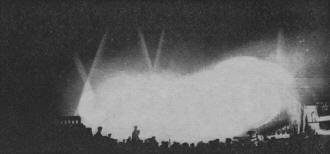
Russian civilians are well trained in what to do when the air
raid alarm comes. This photo shows an anti-aircraft demonstration in Moscow.
by Lucien Zacharoff
Will the USSR be an Achilles' heel to the Nazi iron boot? That's the most asked
question today. Here, an eminent analyst explains the real Red war power.
The document which contained Germany's declaration of war against the Soviet
Union will also be recognized by future historians as the death warrant of Hitlerism
over Europe!
Attacking the USSR, the Nazis have tackled an adversary that uses their own lightning-stroke
strategy and tactics. Many of the practices that prevail today in the German armed
forces originated with the Red General Staff, which also has in store a number of
overwhelming advantages over Berlin's blitzkriegers.
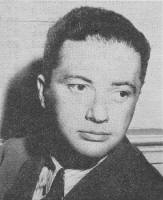
Mr. Zacharoff, author of "This Is War!" and other hooks, is associate
editor of "Aerosphere" and is an internationally known commentator on aviation developments
for the leading American and European newspapers, magazines and syndicates.
Since in any blitzkrieg concept a conspicuous place of honor is assigned to air
warfare, readers of Flying Aces will be watching with particular interest the reports
of the titanic struggle between the two military giants of Europe, where for the
first time in modern military history it's blitz for blitz on an imagination-staggering
scale.
Until that fateful night in June when the German war machine had swooped down
over the frontiers which only a scant few months before the Berlin government had
pledged through a non-aggression pact to respect, it might have been said that a
set of time-tested war doctrines of England and her allies was pitted against the
latest and most daring combat techniques of Germany. With the USSR a belligerent,
however, the Wehrmacht became due for a taste of its own medicine plus.
What does the Luftwaffe aspire to achieve on the Eastern front? Long before the
outbreak of the second World War, authoritative German military writers had defined
the air arm as a weapon possessed of the greatest range of all and therefore admirably
suited for gaining a decision in lightning warfare.
In the time-table strategy of totalitarianism which attacks by surprise first
and declares war later if at all, aviation is assigned the task of striking and
paralyzing the victim country far behind the front lines. In the March, 1936, issue
of Militarwissenschaftliche Rundschau, official organ of the German Air Ministry,
Major E. Bartz wrote:
"Technical possibilities exist today of shattering the resistance of the enemy
country both physically and morally at the earliest possible stage of the war by
persistent, sudden, and unexpected bombing attacks."
And a few months later a well-informed French commentator, Didier Poulain, said
that the Luftwaffe was "intended for sudden attack and destruction."
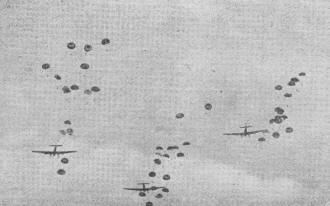
If and when Germany begins to crack, Russia will undoubtedly
dispatch parachutists far behind the lines to stem retreat. (Sovfoto)
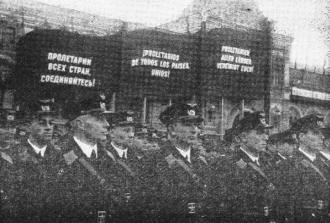
The USSR has thousands of highly trained and skilled flyers.
Their courage is being demonstrated daily against advancing Nazis.
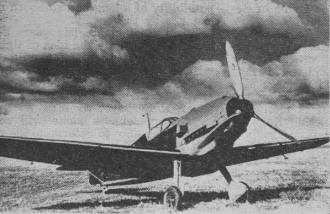
Standard German fighter is the Me. 109. Luftwaffe reports have
it that the ship is better than any similar Red type. (Aerosphere)
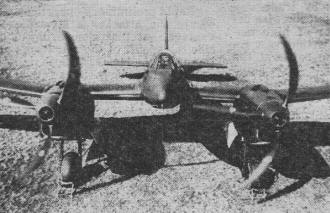
Latest Nazi "destroyer," the Focke-Wulf 187 is reported to be
in service in the East, Both m.g.'s and cannon are mounted.
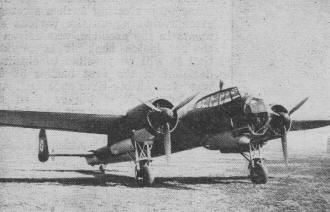
Dornier bombers were used over Moscow on first raid. (Aerosphere)
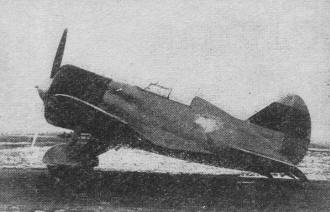
Stock single-seater of the Red Air Force is this Avia fighter.
It has a top speed of 248 m.p.h. and mounts several machine guns.
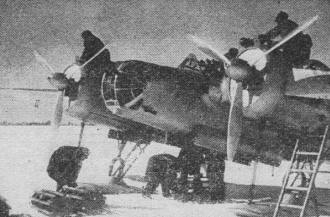
One of the most modern medium bombers in the USSR is the Katiuska.
It is seen here in operation against the Finns.
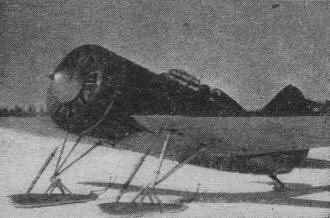
Below: Also known as Chatto, the Avia uses a Wright Cyclone.
(HB Syndicate)
Preparing his "irresistible" army of the air, General Wever, Chief of the German
Air Staff, who was killed in an accident in 1936, built it around hard-hitting bomber
squadrons - a pattern preserved to this day. Perhaps 60 percent of the first-line
planes are bombers.
These aerial armadas are the means appointed by the Berlin brain trusters as
a prime factor in their strategy of lightning decision. This strategy calls for
a ruthless, overwhelming, unannounced invasion, so stunning to the victim that the
war begins and ends as a one-act show.
Planners of the blitzkrieg war never take into account the possibility that Nazi
Germany may be counter-attacked. Their schemes are exclusively offensive, and until
their incursion into the USSR the strategy had justified itself. No provisions have
ever been made by Hitler's generals for a defensive war.
When they had over-run Norway, France, the Low Countries, the Balkans, the Germans
were translating into action their two-fold doctrine of long standing: (a) Mighty
and unexpected attack, lightning-like, by an army splendidly equipped, penetrating
far into the mobilization territory of the enemy, sowing panic throughout the victim
areas; (b) clocklike, very fast, and uninterrupted offensive. Such operations were
possible in Western and Southern Europe, thanks to a high concentration of shock
troops and, mountains of first-class fighting equipment, including aviation, tanks,
and other motorized-mechanized facilities.
Decisive battles were called for at the very outset while the enemy was still
to recover from the initial blow. Mobile, strong numerically and in technological
resources, the German warriors of the land, naval, and air arms had been eminently
successful in making such theories a living reality until Hitler decided to apply
his war doctrine to the Union of Soviet Socialist Republics.
Before comparing German and Red strategy, which shows some surface similarities
and which is now undergoing its own acid test, it may be well to recall that in
a large part the lightning-stroke policy of the German General Staff is motivated
by the need of completing its wars promptly or facing a fatal shortage of raw materials
vital in building and replenishing the machinery of war; the Third Reich, endowed
with an outstandingly well-geared industry, is notoriously poor in petroleum, aluminum
ores, and other natural wealth essential to a smooth functioning of the armed forces.
It leans very heavily on imports, which in wartime must often be procured by conquest
rather than by trade.
The Red General Staff likewise believes firmly in a war of high mobility. It
also demands that vast resources be hurled into battle at the outset. However, it
refuses to stake all its chances on the initial surprise attack, no matter how powerful
it may be. It decidedly figures on the possibility of a long and stubborn resistance
by the enemy.
When Nazi strategists years ago began to propagate the idea of lightning decision,
the Soviet military writers offered the following replies. In the May 16, 1936,
issue of Krasnaya Zvezda, the Red Army newspaper, E. Sergeyev wrote:
"No, suddenness alone will certainly not suffice to determine the result of the
preliminary operations. In the last resort, the advantage will be with the army,
which is numerically stronger, better equipped technically, and better prepared,
and above all the army which knows what it is fighting for."
Augmenting this analysis: F. Novoslobodsky declared in the same organ on June
24 of the same year:
"Rapid preliminary operations may secure the attacker a strategic advantage,
but that alone will not decide the upshot of the war itself; and therefore the hopes
of those military experts who believe that a future war can be won by a lightning
blow, that the modern military technology makes this possible, and that brilliant
leadership will be able to realize it in practice, are vain."
The accuracy of these views is being borne out at this writing by the news cables
and communiques from Europe. If the Nazis were averse to accepting criticism from
their Bolshevik foes, they might have heeded the warning of their First World War
General, Ludendorff, himself a well-known advocate of impetuous aggression. He,
though acknowledging the necessity for Germany of perfecting such a strategy, after
reckoning up the various elements in the problem, was driven to the conclusion that
"it is unlikely that it will be possible to obtain a decision in the first battles
of the war" from a big-time opponent. And they don't come bigger than the USSR,
as was found out by Napoleon who is generally conceded to have been a greater military
genius than Hitler is.
Again, the Nazis might have tempered their ambitions by a warning from another
competent German source, the Militar-Wochenblatt which on October 28, 1934, urgently
stated:
"A strategic raid is a very delicate matter, because although it offers a tempting
chance it also represents a great and terrific risk. We must remember especially
that the loss of prestige which would result at the very beginning of a war for
any country which carried out such a raid unsuccessfully would be incalculable."
So let us admit the possibility that the first thrust of the Nazi armed forces,
however unexpected and powerful, may be deflected by a well-prepared foe. If that
happens, what strategic alternative has Berlin prepared? By its own admission made
repeatedly, only successful offensive Warfare has been planned.
To be sure lightning decisions have been secured in Western Europe, against incomparably
weaker and smaller opponents. But these marvelous victories were not always secured
by the might of arms alone, for Fifth Columnist undercover work in instances frustrated
or delayed effective resistance by the defense.
By turning eastward to open up a new front, however, Germany raised a very different
question. The territories to be taken are enormous - many times bigger than all
the preceding conquests put together. Sudden invasion here, even if the attacked
side is not expecting it, merely gains the fringes of the huge whole.
If after two years of arduous effort Germany has failed to subjugate the small
and exposed England, with the trump cards of suddenness and lightning blow productive
only against such poorly protected objectives as Southeastern Europe and other smaller
countries, how can she take by surprise one-sixth of the globe's surface which is
the USSR? The latter is also credited by unbiased students with at least as mighty
a war establishment, including the air arm, as the Third Reich itself.
We need only recall what competent observers in Germany and other leading European
nations were saying about the Soviet air force before the high-running passions
of wartime either silenced them or caused them to change their tune at the behest
of propaganda ministries. Colonel von Bulow in the official publication of the German
war ministry, for instance, declared: "In recent years the air force of Soviet Russia
has been strengthened to such an extent that it is now the strongest in the world.
It forms the core of the whole military strength of Soviet Russia."
Captain Liddell Hart, outstanding British military critic, said: "The Soviet
Russian air force is the strongest in Europe at the moment." Pierre Cot, French
air minister, reporting to the war ministry, announced: "The air force of the Soviet
Union is already the strongest in the world, and it is rapidly being strengthened
still further." General Faifr, Commander-in-Chief of the Czecho-Slovak air force,
contributed this: "It has already been proven that the Soviet Union has not only
capable and splendidly trained airmen but that Soviet aviation is ahead of all others
in the world in respect of its material."
In the light of such a consensus from the most authoritative quarters abroad,
it may not sound at all boastful for Soviet General Khripin, then second in command
of the air force, saying five years ago: "Our air force is a powerful weapon which
can stand comparison with the air forces of all other countries in numerical strength,
in equipment, in training of personnel, in the cohesion of cadres, and in the readiness
of its members to make the utmost sacrifice in the event of war."
Thus it is quite evident that in attacking the USSR, Hitler is not dealing with
a handful of Norwegian fisherman or Greek sheep herders. Furthermore, not only are
the Russians numerically superior, equipped with the best material, with the background
of inexhaustible national wealth and strategic raw materials, but their ranks are
clearly free of Fifth Column infection, if we are to believe one of the recent United
Press dispatches from Berlin quoting the Nazi reporters' opinion of the Russian
fighters: "These fellows fight only with the consistency of madness, until they
cannot move a limb. They do not surrender." A German radio broadcast adds: "The
Russian soldiers display inordinate fanaticism."
Definitely, the Nazis thought that their combined air and land assault would
turn out to be a pushover. Today they designate as "fanaticism" the Soviet national
unity and stiff resistance to their initial surprise blows. Will words fail them
when tomorrow/they lose that initiative altogether and their rapid, blitzkrieg advance
to the Stalin Line is turned into a rout and they are pushed back from the USSR?
In accordance with the well-known principle of total war, it is not to be doubted
that into that first blow had been focused all the strength, all the preponderance
of advantage that could be mustered. It was an all-out bid to win mastery in the
air. The Germans tried to be equally decisive through their surprise attack by destroying
all the Soviet aircraft possible on the ground.
Yet the latest reports from the far flung battlefields tell us that the Red air
force is hitting back with increasing ferocity and effectiveness, which means that
the aggressor's attempt to win aerial supremacy is already frustrated. The best
that the German air commanders can hope for at this stage is mutual extermination.
However, since the Soviet air force has weathered what was obviously the highest
wave in the Nazi hurricane, the tide is apt to turn wry soon to Berlin's disadvantage.
It is extremely questionable if the Luftwaffe will ever again gather strength for
a more crushing drive than it made at the outset.
Even if the material and moral effects of the German air weapon's blunting in
this attempt were not so pronounced, even if it were able to continue fairly unimpeded
operations over Soviet territory, before reaching important industrial centers which
it must strike it would nave to fly over thousands of miles of embattled terrain
and face the swarms of defending aircraft and plentiful installations of anti-aircraft
artillery.
The bulk of the USSR's industrial centers and industrial populations is beyond
reach of the farthest-flying German bombers, which were never confronted with such
a handicap in any of their previous campaigns. Among the world's powers, only the
USSR and the United States are so advantageously situated.
Not only is the Soviet Union amply prepared to meet the situation through its.
powerful air force coordinating with other arms, but its reservoir of manpower and
technical facilities is virtually unlimited. That nation of 200,000,000 has a civilian
air defense society with 15,000;000 members. Not only was it in the USSR that the
parachuting expeditionary force had been conceived as well as air infantry and other
innovations imitated by the German High Command, but because of all these powerful
elements at the disposal of the Moscow government the Red air strategy will not
content itself with passive defense, however telling. Their air specialists visualize
their fighting aircraft as a weapon of offense eminently suited for operations deep
in hostile territory. Numerous Soviet flying fortresses have ranges of more than
2000 miles and are based so that they can raid important objectives in any part
of German territory in their independent operations and return home with fuel to
spare. This immediately gives the Soviets an upper hand.
Whether independently or in close coordination with tanks, artillery, infantry,
and possibly naval units, the air arm, according to the Soviet tacticians, must
be utilized as a mass strength in battle.
In view of this it should be expected that very soon the news dispatches will
be informing us that the Red air force is closing in on the enemy from above, is
obtaining and maintaining command in the air, is attacking from the unprotected
flank, and is paralyzing the Nazi lines of communication.
Developed to an extent unequalled in any other military establishment, Sovie
t transports of, many thousands of parachutists and flying infantrymen may soon
be descending in the heart of the enemy country far behind the front lines. As early
as 1938, German military writers, while belittling the idea, were reporting that
the Red army had more than 70,000 parachuting fighters in service.
Without deluding themselves that they can knock out the enemy without some defensive
operations (for which they are well prepared) the Red High Command primarily bases
its strategy on counter blows and offensives of their own. And it should be remembered
that while they have a superior air force, it is but one of the many potent modern
weapons in the arsenal of Soviet national defense. Close students of Soviet strategy
know that if Hitler is defeated by the USSR, through its superior manpower and preponderance
of armament as well as geographical advantages, there will be no possibility of
the routed enemy's retreat or even flight. The final phase of the strategic offensive
of the Red army offers to the foe only the alternatives of complete surrender or
complete destruction, if we are to believe the following picture painted in a leading
Russian military journal several years ago: "The enemy is defeated and seeks to
withdraw from the battlefield, to preserve his forces intact, and save his equipment
and stores. However, his line of retreat is cut off by long-distance tank units
and by mechanized air and land corps which have penetrated deep in the territory
behind his front lines. Everywhere the demoralized enemy is met with the fight of
attacking units which have broken through his flanks and taken him in the rear.
The encirclement closes in more and more tightly, until finally the enemy is compelled
to lay down arms."
If the Red strategy is so realistic in a consideration of the USSR acting alone
against Germany, it becomes overpoweringly so in the face of the British and American
collaboration with Moscow. Germany's creation of a new front makes it immeasurably
easier for the Royal Air Force to strike in the West and for the British General
Staff finally to reach the decision to land on the Continent. On the other hand,
speaking of Germany's allies, Italy is playing the token part in the anti-Soviet
war. Smaller Axis satellites, like Finland, Rumania, and Hungary, are not strategically
decisive for either Germany or the Soviet Union.
Thus, the essential differences between the Nazi and Soviet strategies, particularly
in respect of air combat, indicate that for the first time Germany is faced with
the prospect of reaping the whirlwind of total war to a greater extent than she
has ever sown it. It will also be the last time, I feel positive.
Posted July 22, 2023
|




